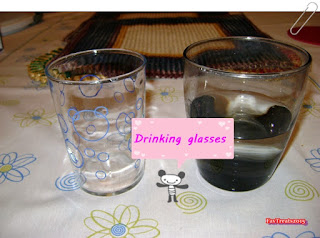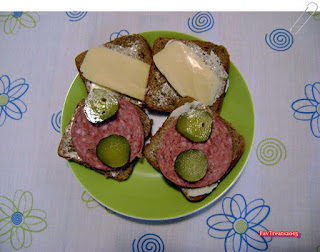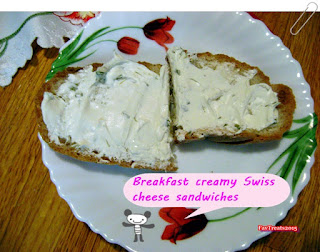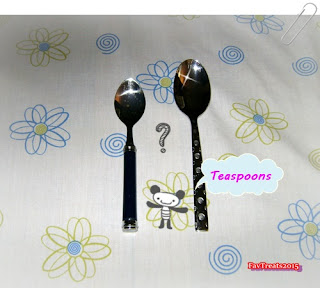All in all, with the help of my husband, I was trying to find myself among all the new items. Nevertheless, I had some problems with finding particular products, which I would call 'pantry basics'.
First thing which I learned was that vanilla sugar is not available here. It surprised me because it is nothing unusual in Poland. Actually, vanilla sugar is quite a common item, and used as a cake/cookies ingredient much more often than vanilla extract. Some other difficulties which I encountered trying to find various groceries were connected with 'vocabulary differences'. Well, I had not known about them. For example, when I asked about corn flour (this is the name used for the product in Poland), nobody knew what I meant. Later I learned the thing is called 'corn meal' here. Another, quite funny example of a slight difference in naming, is elbow pasta, which is called 'little knees' in Poland.
Ah, and potato flour, another essential of the Polish pantry, which is both popular and inexpensive there. I was not able to find it in local shops. Searching the Internet I found out how ridiculously pricy and really rare the flour is here. Thanks to my own research I learned a new thing again: cornstarch is used instead of potato flour as both products have similar properties.
Besides it, there is something else which I find rather interesting too. In Poland sugar is made of white sugar beets not sugar cane. Due to the different and colder climate, sugar cane is not grown there. But both kinds of sugar look and taste the same.
After some time I got used to it all (including the layouts of particular stores) and these days I am able to actually notice the groceries displayed on the shelves. What is more, I enjoy buying and trying new things too. On the other hand, having tried some of the best selling kinds/brands of bread here, I admit I was disappointed that all of them are sweet. Simply because it is not what I got used to growing up and living in Poland. Neither sandwich bread nor hot-dog or hamburger buns are sweet (well, at least they shouldn't be, according to what I had got used to). I decided to start making bread and rolls at home, with very pleasing results! No, we do not have a bread machine. I mention this because I have heard about such an attitude that one cannot make bread if they have not bread machine (I wrote a short post about it), which really makes me laugh.
 |
| Yeast Rolls made by myself |
Anyway, after several visits in various grocery stores, I found kinds of bread which I like - they are called Italian and French bread. Also, Kaiser rolls and sourdough rolls taste similarly to the bread I used to eat in Europe. However, there are some differences in serving the bread here and in my home country.
1. Sandwiches
Sandwiches are also eaten for breakfast and supper in Poland. They are a bit different than lunch sandwiches though. Mainly because they are made of single slices of bread (instead of two) which are cut in two halves. Another difference is that butter or butter like spread is used to make a sandwich (not mustard). What else is served on a sandwich depends on personal likes of course. Typically, for breakfast it can be some cottage cheese, cream cheese or just a slice (1) of ham, cheese, sausage or other meat + a slice of tomato/or and egg/or and pickle/ some lettuce. More or less the same kind of sandwiches would be served for supper too.
When I told my mum that mustard is used on sandwiches (instead of butter) here, she was surprised and asked me whether it is because local people happen have cholesterol problems. I guess some do but it is rather a matter of a different custom than a total health concern.
2. Bread
Bread is eaten mainly for breakfast, lunch and supper. Usually NOT for dinner. However, certain kinds of soup (eg. vegetable soup) is sometimes served with a slice of bread - which is not sweet, and with no butter). All the sweet things baked in a loaf shaped tin such as banana bread, lemon bread and others, would be called cakes (banana cake, lemon cake, etc.) in Poland. Bread is usually not sweet and cakes are sweeter of course - they are two different things.
 |
| White bread made by myself. |
 |
| .............or banana cake :) |
3. Meals
A typical Polish family eat home made meals more often than they go out. Because of different, also economical, reasons - there are no such things like discount coupons there. I like cooking and baking too but, from time to time, I do enjoy having a break and appreciate a nice restaurant meal.
What I like about food places in the States is free drink refills. In Europe you pay for every glass of soda or water you drink. If you empty one glass, you need to buy another one if you are still thirsty. Unless you are at a local Pizza Hut place - they have the same rules about free refills as they are in the US.
Another thing is the size of dishes served in the local restaurants. At first, I was amazed at the amount of food - the lunch and dinner portions I got in the States. Usually the bread and drink would be enough for me. If I eat the bread (which I really like) and some appetizer, I am hardly able to eat anything more. In restaurants in Poland, a dinner plate usually meant more food than I normally ate at home but still, even if I was overeaten at the end, I was also most often able to cope with my dish and eat it (almost) all. So there was never such a thing like taking the leftovers home. If you happened not to eat everything, what was left was not worth thinking about, too little to have another meal.
 |
| Two sizes of dinner plates: American & Polish |
Well, surprisingly, the sizes of dinner plates (home dinnerware), teaspoons and coffee cups are bigger in the States than in Europe too.
 |
| Most popular size of a Polish drinking glass = the size of 1 cup, American kitchen measure. Of course bigger glasses are available in Poland too. |
Typical Polish meals (of course there are exceptions depending on personal kikes and needs)
Breakfast:
- a bowl of cereal with hot/warm or cold milk or
- a milk based soup - mainly for children or
- scrambled eggs or
- cooked sausage or
- sandwiches - single slices of bread also with honey/jam or dairy products/ham/sausage slices etc.
Some work places have lunch breaks/canteens, some do not. At the latter ones people eat their sandwiches (double bread slices) or whatever they bring from home, while doing their work, whenever they can.
 |
| My lunch sandwiches |
Lunch menu at state schools is prepared by school dietitians and meals are made by school cooks. The meal usually consists of a soup, main dish, some (prepared in the school kitchen) fruit drink and a dessert (most often a yoghurt or a fruit). Friday is typically a meatless day. Lunch break is quite short - lasts 25 up to 30 minutes, so there is not much time to enjoy the meal. Students whose parents choose not to buy lunch at school, eat their sandwiches brought from home, outside the canteen. However, kids coming from poor families have their school lunches sponsored by local community councils.
Dinner - usually a home made meal eaten when back from work. On Sundays and holidays lunch is skipped and dinner is simply eaten much earlier.
Supper - served later in the evening/night
(if dinner was early enough and one gets hungry again), most often it is something light (eg. sandwiches) and not sweet. Sometimes it is also scrambled eggs or a cooked sausage or/and other things.
 |
| Our home made hamburges & home baked buns |





No comments :
Post a Comment